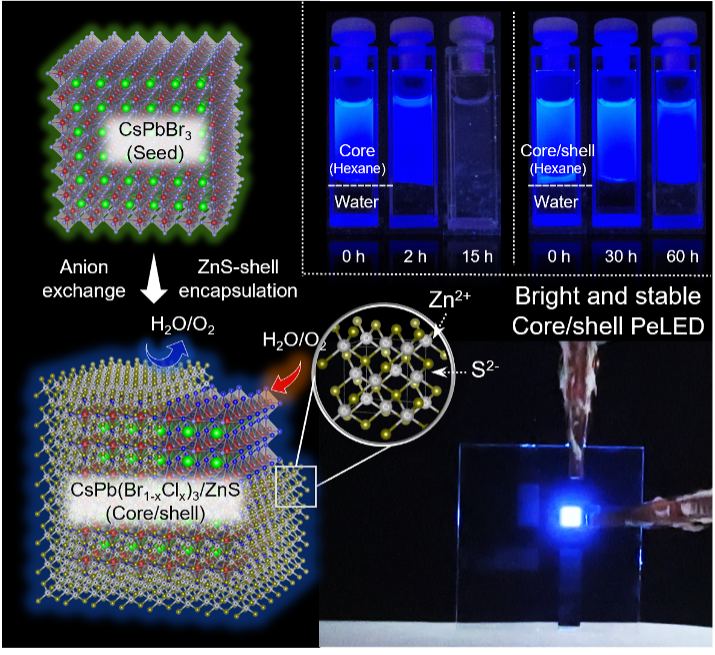Perovskite Nanocatalsts Protected by Hermetically Sealing for Highly Bright and Stable Deep-Blue Light-Emitting Diodes
| author | Dong Hoon Choi, Kwangyeol Lee |
|---|---|
| Homepage | http://nanolab.korea.ac.kr/ |
| journal | ADVANCED SCIENCE |
Metal–halide perovskite nanocrystals (NCs) have emerged as suitablelight-emitting materials for light-emitting diodes (LEDs) and other practicalapplications. However, LEDs with perovskite NCs undergoenvironment-induced and ion-migration-induced structural degradationduring operation; therefore, novel NC design concepts, such as hermeticsealing of the perovskite NCs, are required. Thus far, viable syntheticconditions to form a robust and hermetic semiconducting shell on perovskiteNCs have been rarely reported for LED applications because of the difficultiesin the delicate engineering of encapsulation techniques. Herein, a highlybright and durable deep-blue perovskite LED (PeLED) formed by hermeticallysealing perovskite NCs with epitaxial ZnS shells is reported. This shellprotects the perovskite NCs from the environment, facilitates chargeinjection/transport, and effectively suppresses interparticle ion migrationduring the LED operation, resulting in exceptional brightness (2916 cd m−2)at 451 nm and a high external quantum efficiency of 1.32%. Furthermore,even in the unencapsulated state, the LED shows a long operational lifetime(T50) of 1192 s (≈20 min) in the air. These results demonstrate that theepitaxial and hermetic encapsulation of perovskite NCs is a powerful strategyfor fabricating high-performance deep-blue-emitting PeLEDs.

« Prev Molecular Thermoelectricity in EGaIn-Based Molecular Junctions
 Molecular Thermoelectricity in EGaIn-Based Molecular Junctions
2023.12.20by webmaster2
〈
Molecular Thermoelectricity in EGaIn-Based Molecular Junctions
2023.12.20by webmaster2
〈
The importance of a charge transfer descriptor for screening ... Next »
 The importance of a charge transfer descriptor for screening ...
2023.07.04by webmaster2
〉
The importance of a charge transfer descriptor for screening ...
2023.07.04by webmaster2
〉
Articles
- Self-Aggregating Tau Fragments Recapitulate Pathologic Phenotypes and Neurotoxici...
-
 Ultranarrow Mid-infrared Quantum Plasmon Resonance of Self-Doped Silver Selenide ...
Ultranarrow Mid-infrared Quantum Plasmon Resonance of Self-Doped Silver Selenide ...
-
 Molecular Thermoelectricity in EGaIn-Based Molecular Junctions
Molecular Thermoelectricity in EGaIn-Based Molecular Junctions
-
 Perovskite Nanocatalsts Protected by Hermetically Sealing for Highly Bright and S...
Perovskite Nanocatalsts Protected by Hermetically Sealing for Highly Bright and S...
-
 The importance of a charge transfer descriptor for screening potential CO2 reduct...
The importance of a charge transfer descriptor for screening potential CO2 reduct...
-
 Resonant Raman-Active Polymer Dot Barcodes for Multiplex Cell Mapping
Resonant Raman-Active Polymer Dot Barcodes for Multiplex Cell Mapping
-
 Decoding the Roles of Amyloid-β (1-42)'s Key Oligomerization Domains toward Desig...
Decoding the Roles of Amyloid-β (1-42)'s Key Oligomerization Domains toward Desig...
-
 Flattening bent Janus nanodiscs expands lattice parameters
Flattening bent Janus nanodiscs expands lattice parameters
-
 Directing the surface atomic geometry on copper sulfide for enhanced electrochemi...
Directing the surface atomic geometry on copper sulfide for enhanced electrochemi...
-
 High Seebeck Coefficient Achieved by Multinuclear Organometallic Molecular Junctions
High Seebeck Coefficient Achieved by Multinuclear Organometallic Molecular Junctions
-
 Thermopower in Transition from Tunneling to Hopping
Thermopower in Transition from Tunneling to Hopping
-
 An Activity-Based Fluorescent Probe for Imaging Fluctuations of Peroxynitrite (ON...
An Activity-Based Fluorescent Probe for Imaging Fluctuations of Peroxynitrite (ON...
-
 Deep learning for development of organic optoelectronic devices: Efficient prescr...
Deep learning for development of organic optoelectronic devices: Efficient prescr...
-
 Photocatalytic Superoxide Radical Generator that Induces Pytoptosis in Cancer Cells
Photocatalytic Superoxide Radical Generator that Induces Pytoptosis in Cancer Cells
-
 Direct C-H metallation of tetrahydrofuran and application in flow
Direct C-H metallation of tetrahydrofuran and application in flow
-
 Functionalization of Diamine-Appended MOF-Based Adsorbents by Ring Opening of Epo...
Functionalization of Diamine-Appended MOF-Based Adsorbents by Ring Opening of Epo...
-
 High Gravimetric and Volumetric Ammonia Capacities in Robust Metal-Organic Framew...
High Gravimetric and Volumetric Ammonia Capacities in Robust Metal-Organic Framew...
-
 Li-ion Intercalation, Rectification, and Solid Electrolyte Interphase in Molecula...
Li-ion Intercalation, Rectification, and Solid Electrolyte Interphase in Molecula...
-
 Thermopower of Molecular Junction in Harsh Thermal Environments
Thermopower of Molecular Junction in Harsh Thermal Environments
-
 Microfluidics-Assisted Synthesis of Hierarchical Cu2O Nanocrystal as C2-Selective...
Microfluidics-Assisted Synthesis of Hierarchical Cu2O Nanocrystal as C2-Selective...
Designed by sketchbooks.co.kr / sketchbook5 board skin